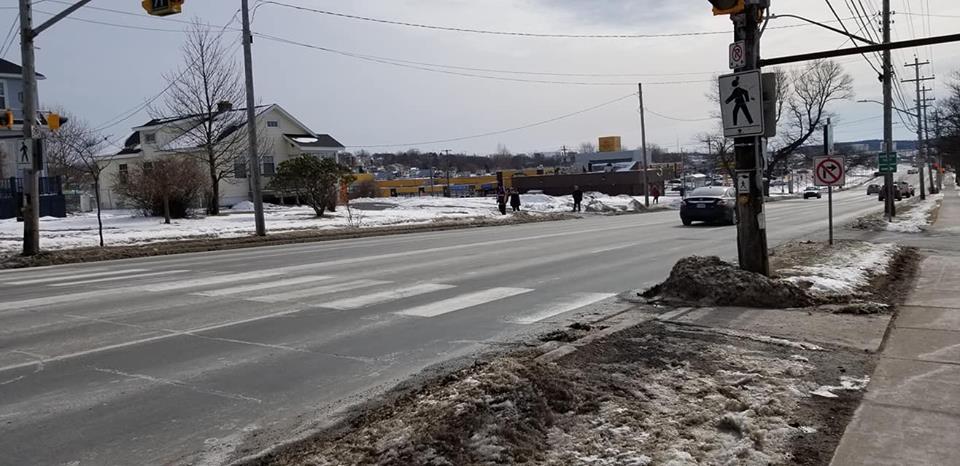KJIPUKTUK (Halifax) – A 57 year old man crosses the street at a dangerous stretch of road and is hit by a driver who doesn’t stop. His last few moments of life are unimaginable, and the circumstances of his death a cause of indescribable grief and loss for his family.
Perhaps last week was Halifax’s worst ever week in decades. It’s hard to imagine worse.

The incident near 350 Pleasant Street in Dartmouth marks the fifth pedestrian fatality in our municipality in just over a year, and the fifth hit and run involving a pedestrian in just two months – police have appealed for information from the public about drivers who hit pedestrians and then disappeared on 23 December 2018, 15 January, 16 January and 30 January 2019.
What needs to happen now?
Not silence, or plain hoping things will improve will suffice. Pedestrians (and that’s nearly all of us at one time or another) might reasonably expect a statement from leadership providing assurance that a strategy and funding will soon be in place to improve the unacceptable situation.
We also need some unequivocal words from the police and our governments regarding the danger to all road users caused by irresponsible and criminal driving, in particular to vulnerable road users like pedestrians and cyclists.
Most of all, we need to know that addressing the danger and death on our roads is a priority for all our levels of government, not just in words, but also in our budget.
What are the fixes?
The fixes to our bloodshed crosswalks are a constant source of debate for Haligonians, encouraged even by our municipality , which asked us for our ideas on how to make our crosswalks safer in ads still splashed over our buses, only to inform us in the small-print that in fact they would not accept proposals on crosswalk safety from individuals.
Most agree we do need improved infrastructure and enforcement efforts of some kind. Education has an unproven history, so I was glad when staff recognised the Heads Up Halifax campaign could cause more harm than good by escalating the blame game:
“Using the perspective of drivers and pedestrians to illustrate unsafe behaviors at crosswalks and the disconnect behind their risk assessment in these situations appears to be spreading the opportunity for key audiences (drivers and pedestrians) to blame each other for collisions in crosswalks.”
Didn’t we adopt Vision Zero?
Thankfully we have moved on from hashed attempts at education to the proven Swedish Vision Zero (no deaths) methodology, which focuses on applying infrastructure fixes that resolve and mitigate common driver and pedestrian errors. An example could be using red stop lights at crosswalks, which provide a clear and certain signal for drivers to stop.
But when we last checked in on our Vision Zero plan in July, our “plan” was downgraded into a “framework” because we did not yet have the the required “foundational analytic tools” (i.e. software to process our incident data) that we need before we even begin to formulate any kind of evidence based road safety action plan.
So we have no action plan because the job of working out who’s getting hit where, why and how got overlooked until just recently. Even though the need for an evidence based road safety plan to make our crosswalks safer was flagged in a comprehensive 125 page report by our traffic authorities way back in 2007.
We have the money, it’s just a matter of priorities
Even if we do crunch the data and work out what safety countermeasure/fix can be applied where, the available cash is limited – just $215,000 is allocated for our road safety improvement program in the draft 2019/2020 financial year budget. We’re not broke, however. The Scotiabank Centre have $4.54 million allocated for improvements, including a replacement scoreboard.
So can we realistically expect conditions on our roads to get any safer at all? The police are not certain of gaining the budget increases they say they need. We don’t have anywhere near the cash we will likely need to initiate an effective HRM-wide road safety plan. Neither do we seem to have the organisation, or the statements of commitment from leadership to implement emergency measures to make our streets safer.
Council likes to talk about a modern city with modern expensive transportation options including commuter rail and Bus Rapid Transit, but it seems we’re just not committed enough to fix the basics of how we cross the road to get to this modern transportation.
So we’re just left to wonder how many people will pay the ultimate price on our dangerous roads, and hope it won’t be us or our loved ones.
If you walk, cycle or use a wheelchair and are affected by road safety issues, please join HRM Safe Streets for Everyone. If your local crosswalk needs a crosswalk flag, please contact the Crosswalk Safety Society. Please remember to report issues affecting your safety to our municipal authorities using the 311 service.
With a special thanks to our generous donors who make publication of the Nova Scotia Advocate possible.
Subscribe to the Nova Scotia Advocate weekly digest and never miss an article again. It’s free!



